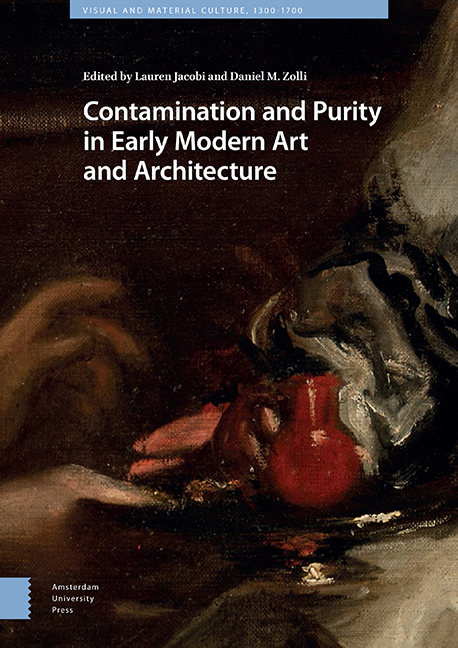Book contents
- Frontmatter
- Contents
- List of Illustrations
- Introduction: Contamination and Purity in Early Modern Art and Architecture
- 1 Generation and Ruination in the Display of Michelangelo’s Non-finito
- 2 The Sacrilege of Soot: Liturgical Decorum and the Black Madonna of Loreto
- 3 Sedimentary Aesthetics
- 4 ‘Adding to the Good Silver with Other Trickery’ : Purity and Contamination in Clement VII’s Emergency Currency
- 5 Tapestry as Tainted Medium: Charles V’s Conquest of Tunis
- 6 Bruegel’s Dirty Little Atoms
- 7 Leakage, Contagion, and Containment in Early Modern Venice
- 8 Contamination, Purification, Determinism: The Italian Pontine Marshes
- 9 Colonial Consecrations, Violent Reclamations, and Contested Spaces in the Spanish Americas
- 10 Contamination | Purification
- Index
9 - Colonial Consecrations, Violent Reclamations, and Contested Spaces in the Spanish Americas
Published online by Cambridge University Press: 27 May 2021
- Frontmatter
- Contents
- List of Illustrations
- Introduction: Contamination and Purity in Early Modern Art and Architecture
- 1 Generation and Ruination in the Display of Michelangelo’s Non-finito
- 2 The Sacrilege of Soot: Liturgical Decorum and the Black Madonna of Loreto
- 3 Sedimentary Aesthetics
- 4 ‘Adding to the Good Silver with Other Trickery’ : Purity and Contamination in Clement VII’s Emergency Currency
- 5 Tapestry as Tainted Medium: Charles V’s Conquest of Tunis
- 6 Bruegel’s Dirty Little Atoms
- 7 Leakage, Contagion, and Containment in Early Modern Venice
- 8 Contamination, Purification, Determinism: The Italian Pontine Marshes
- 9 Colonial Consecrations, Violent Reclamations, and Contested Spaces in the Spanish Americas
- 10 Contamination | Purification
- Index
Summary
Abstract
During Spanish colonization in the Americas, Catholic evangelizers often purposefully consecrated spaces that were already sacred to Indigenous Americans. In many regions, however, Indigenous deities, spirits, ancestors, and their devotees, rebelled. The Pueblo Revolt of 1680 killed and evicted Spaniards while claiming Christian constructions and objects for native usage. Yet the end result of this revolt was not just the re-consecration of sacred spaces to once again welcome Indigenous spirit beings. Rather, in its wake, the line between the pure and the contaminated cannot be neatly drawn; indeed, such sharp distinctions make little sense within Indigenous epistemologies wherein binary opposition is rarely found. Comparative materials from Mesoamerica and the Andes help complicate the commonplace narrative of conquest and resistance.
Keywords: Awatovi, Hopi, Kiva, Pueblo, religious conversion, Pueblo Revolt
On a winter morning in 1941, at the Museum of Modern Art in New York City, the Hopi artist Fred Kabotie posed for a picture with the First Lady of the United States, Eleanor Roosevelt (Fig. 9.1). The pair stands in front of a reconstructed kiva mural from Awatovi, a once-thriving Hopi community that had been abandoned in the early eighteenth century. This mural, depicting dancing and masked figures, was one of several painted by Kabotie with help from three of his Hopi art students, Victor Cootswytewa, Herbert Komoyousie, and Charles Loloma, for the museum's exhibition Indian Art of the United States. Although the photograph offers no sense of the museum's interior space, a press release describes the murals as appearing in a reconstructed kiva (defined by the MoMA as an ‘underground ceremonial chamber’). Neither the museum press releases nor the exhibition catalog comment on the fact that these paintings were originally created at a site legendary for its contamination. The museum also remained silent about the violence witnessed at Awatovi in the seventeenth and eighteenth centuries, violence unleashed to purify this place.
The successive waves of ‘contamination’ and ‘purification’ so integral to Awatovi's legacy reveal how tangled the relationships between these two seemingly incompatible yet coupled notions can become. It is not especially surprising the museum said nothing about Awatovi's complicated history. Pablo Picasso's Guernica – a painting intimately bound to modern violence and warfare – had been exhibited at the MoMA just a year earlier, but colonial conflagrations of the past, and among the Hopi, figured in a wholly other register.
- Type
- Chapter
- Information
- Contamination and Purity in Early Modern Art and Architecture , pp. 283 - 314Publisher: Amsterdam University PressPrint publication year: 2021

